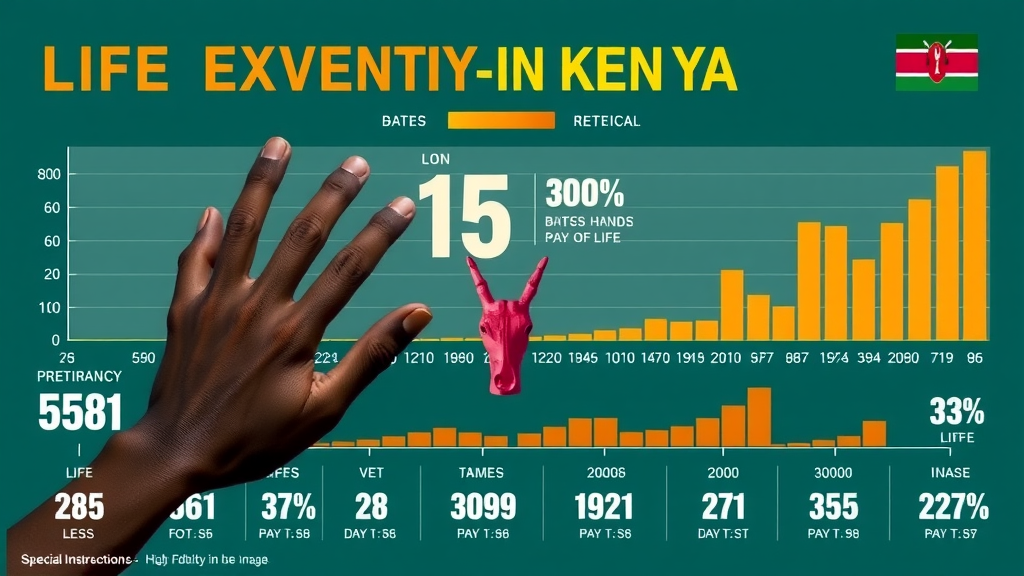Did you know that the life expectancy in Kenya has increased significantly over the past few decades? While this may seem like an overwhelming positive trend, a deeper dive into the numbers uncovers surprising statistics and influencing factors that aren't often highlighted. Discover how socioeconomic elements contribute to these numbers and learn what they truly indicate about the nation's health landscape—and by extension, its future.
The Surprising Reality of Life Expectancy in Kenya
The life expectancy in Kenya is an intriguing subject that encompasses a variety of both expected and unexpected factors. While global improvements in healthcare have played a significant role in increasing life expectancy, socioeconomic disparities still pose significant challenges. In fact, the difference in life expectancy for people living in rural vs. urban areas can be astonishing, revealing a complex reality that is often masked by surface-level statistics.
Shocking Statistics Unveiled

The statistics on life expectancy in Kenya reveal that the average life expectancy is approximately 66 years. However, these numbers only scrape the surface. While urban areas boast higher numbers due to better access to healthcare and services, rural regions often lag behind due to limited resources and infrastructure. This disparity highlights the pressing need for encompassing healthcare reforms and more robust policy interventions aimed at bridging this gap.
The Impact of Socioeconomic Factors on Life Expectancy
Socioeconomic factors have a profound influence on life expectancy in Kenya. Factors such as income inequality, access to quality education, and employment opportunities heavily dictate health outcomes. For instance, a stable job often comes with health benefits that can significantly increase life expectancy, a reality not accessible to individuals in informal employment sectors. This directly influences both the burden of disease and average life expectancy figures in the nation.
| Country | Life Expectancy |
|---|---|
| Kenya | 66 years |
| South Africa | 64 years |
| Nigeria | 54 years |
| Algeria | 76 years |
Key Factors Contributing to Life Expectancy in Kenya
Population Growth and Its Effects

The rapidly growing population in Kenya serves as a double-edged sword influencing life expectancy. On one hand, a youthful population can lead to economic growth and a vibrant workforce. On the other, rapid population growth can strain public health resources, making it challenging to cater for every individual's health needs. As per the current data, population age structure in Kenya skews young, which could benefit the nation's economy, provided there are effective policies in place to support this demography.
Leading Causes of Death and Their Influence
- **Infectious diseases**: HIV/AIDS and tuberculosis remain significant health threats.
- **Non-communicable diseases**: Rising incidences of heart disease, diabetes, and cancer.
- **Accidents and injuries**: Notable causes include road accidents and occupational hazards.

Population Growth: A Double-Edged Sword
Understanding the Balance between Growth and Resources
Population growth in Kenya presents unique challenges and opportunities. While a younger population indicates potential for future development, it also demands sustainable resource planning. Whether it's healthcare, education, or infrastructure, an increasing population necessitates proportional enhancements in these sectors, requiring policymakers to carefully balance growth with resources.
People Also Ask: Insights into Life Expectancy in Kenya
What is the biggest cause of death in Kenya?
Expert opinions reveal that infectious diseases, such as HIV/AIDS and tuberculosis, are the leading causes of death in Kenya. Despite significant public health campaigns and interventions, these diseases still claim many lives annually, highlighting the need for ongoing healthcare improvements and funding.
How long does the average Kenyan live?

The average Kenyan lives approximately 66 years, although this number can vary based on many factors including region, access to healthcare, and socioeconomic status. Urban areas typically report a higher average lifespan due to better health facilities and living conditions as opposed to more rural areas.
Which country in Africa has the longest life expectancy?
According to recent statistics, Algeria currently enjoys the longest life expectancy on the African continent, clocking in at around 76 years. This can be attributed to their robust healthcare systems and proactive public health strategies.
What is the average age in Kenya?
Kenya's population is notably young, with the median age being roughly 20 years. Population age structure greatly affects national policies, economic development, and social dynamics.
Regional Comparisons: Life Expectancy Across Africa
The Leaders and Laggards in African Life Expectancy

Life expectancy across Africa varies dramatically, from Algeria's high of 76 years to Nigeria's low at 54 years. Kenya sits in the middle of this spectrum. The differences reveal underlying disparities in healthcare systems, economic stability, and public health policies across the continent.
The Role of Healthcare Advancements in Life Expectancy
Improvements in Healthcare and Their Effects
Improvements in healthcare are pivotal in increasing life expectancy in Kenya. With advancements in medical technology and the implementation of national health insurance schemes, there's a positive outlook for further enhancing average life expectancy. However, it's crucial to recognize that healthcare infrastructure needs continual upgrading and expansion to sustain this trend.
Conclusion: Interpreting the Data on Life Expectancy in Kenya
To effectively improve the quality of life and increase life expectancy, targeted initiatives and inclusive policies are essential. Strategic public health interventions and systemic advancements in healthcare and education will serve as cornerstones for long-term success.
Frequently Asked Questions on Life Expectancy in Kenya
How accurate are life expectancy figures?
Life expectancy figures are based on a mix of demographic data, health surveys, and statistical models. While comprehensive, they are not infallible and should be interpreted as indicative, not absolute measures.
What measures can improve life expectancy?
Improving healthcare access, investing in education, enhancing public health initiatives, and promoting economic stability are key measures to boost life expectancy. These efforts should be holistic and inclusive to ensure broad-based improvements.
Why is life expectancy important for policy making?
Life expectancy is a vital metric for policymakers, offering insights into the population's health and aiding in the shaping of relevant social and economic policies. It helps in prioritizing areas of need and allocating resources effectively.
 Add Row
Add Row  Add
Add 



Write A Comment